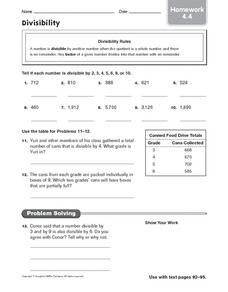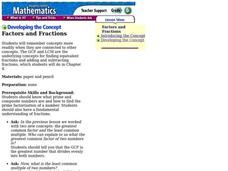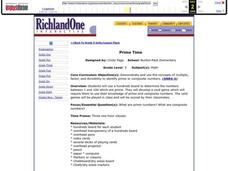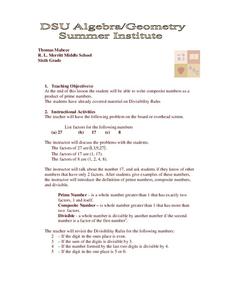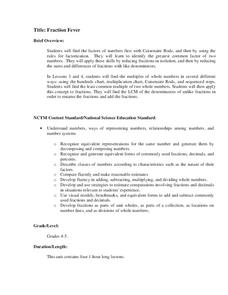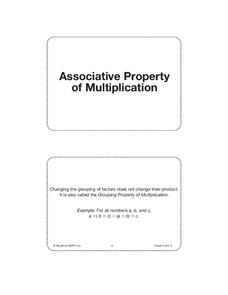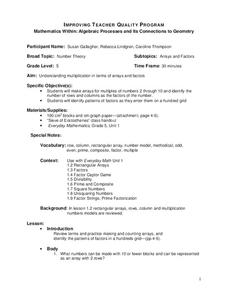Curated OER
Divisibility Rules Using Scientific Calculators
Young learners apply divisibility rules to determine if a number is a factor of another number. They discuss what numbers are factors of another number and identify patterns using divisibility rules.
Curated OER
Smart Cookie Factors
Learners examine the concept of finding the greatest common factor. They complete number of activities as they practice identifying prime and composite numbers. Pupils apply rules of divisibility and find the greatest common factor while...
Curated OER
Divisibility
In this divisibility instructional activity, students read divisibility rules and then check the boxes in the chart if the 3 digit number can be divided by numbers 2 through 10. Students do this for 5, 3 digit numbers.
Curated OER
Divisibility Worksheet
For this divisibility worksheet, students complete 9 problems in which they determine which number is divisible by the given number. They choose between 4 numbers for each divisibility factor. They complete the pages on-line and print...
Curated OER
Divisibility: Homework
In this divisibility worksheet, students tell whether numbers are divisible by given numbers, use a table to solve 2 word problems and solve 1 addition word problem. Houghton Mifflin text is referenced.
Curated OER
Prime Factorization: Finding Factors in the Fifth Grade
The lesson starts out with a brain drain, which is a great way to get students to activate prior knowledge and build lasting connections. They tell everything they know about prime factorization, use their knowledge to...
Curated OER
Math in English Skills X Exercise Book
Provide your remedial math students with a handy packet that will help them practice prime factorization, exponents and roots, and multiplication and division of fractions. The packet includes 20 pages, bright images, and answer keys....
Curated OER
March of the Dividing Ant
Young scholars inspect divisibility rules. In this divisibility rules lesson, students study the relationship between factorization and the divisibility rules for 2, 3, 5, 6, 9, and 10. Young scholars read One Hundred Hungry Ants and A...
Curated OER
Factors and Fractions
Find the greatest common factor of numbers. Learners review prime and composite numbers and how to find the prime factorization of a number. They also review the greatest common factor, least common multiple, and learn new ways to find...
Scholastic
Study Jams! Prime & Composite Numbers
Prime or composite, that is the question. Teach your class how to find the answer with this step-by-step presentation that defines and provides examples of each type of number. When addressing larger numbers, divisibility rules are...
Curated OER
Twenty Questions: The Hundred Chart
Use the 20 Questions game to practice math vocabulary and number properties! Project a hundreds chart and hand one out to learners. Ideally, give them counters (beans would work well) to mark off the chart so you can play multiple times....
Curated OER
Prime Factors
Fifth graders review the concept of prime factorization. Then, they use the rules for divisibility and other notions to find the prime factorization of unfamiliar numbers. They solve problems in a whole class setting.
Curated OER
Prime Factorizations - Post Test
In this prime factorizations worksheet, students complete a set of 10 multiple choice questions. Students may print out the test or click on a link to see answers.
Curated OER
Prime Time
Fifth graders complete activities related to prime and composite numbers. For this prime lesson, 5th graders make a hundreds chart with all the prime numbers. They create their own card game which deals with prime and composite numbers.
Curated OER
Factoring to Find Divisors
For this math worksheet, students find all factors of five two digit numbers. They tell the related division facts. Students list the factors of the numbers.
Curated OER
Introducing the Concept Prime Factors
Fifth graders identify the prime factorization for 48 using different sets of factors. They find the prime factorization for 60.
Curated OER
Prime Numbers and Factors
Solving factor trees is a helpful way to introduce prime numbers. Your math class practices using this method along with two-column tables to find if a number is prime or not. They also learn other vocabulary, such as composite numbers,...
Curated OER
TI-82 PROFICIENCY
Students find the proper factors for numbers one through fifty using either the divisibility laws or TI-82. They determine the sum of the proper factors for each number. If the sum of the factors is less than the number itself, then this...
National Security Agency
Fraction Fever
This unit on fractions allows for upper-aged elementary learners to explore ways to find the greatest common factor and least common multiple of two numbers. Ultimately, young mathematicians will be able to identify equivalent fractions,...
Houghton Mifflin Harcourt
Unit 2 Math Vocabulary Cards (Grade 5)
Twenty-eight flashcards make up a set designed to reinforce math vocabulary. Two styles of cards showcase either a bold-faced word or a corresponding definition card equipped with an example and labels. Terms include commutative property...
Curated OER
Prime and Composite Numbers
Fifth graders investigate the concepts of composite and prime numbers. They factor different numbers and determine the number of factors for each. Based upon this information the number is declared prime or composite.
Curated OER
Mathematics Within: Algebraic Processes and Its Connections to Geometry
Fifth graders discover the connections between algebra and geometry. With a focus on arrays and factors, they are introduced to multiplication. They develop an array for multiples of 2 through 10 and identify the factors of each row....
Curated OER
Prime Factorizations
In this prime numbers worksheet, students answer multiple choice questions about prime numbers and how they are read. Students answer 10 questions total.
Curated OER
Multiplication & Division
Helpful for building a multiplication unit that focuses on different strategies. With explanations about repeated addition and subtraction as foundations for multiplication, scaling, summaries of progression, and basic multiplication and...






